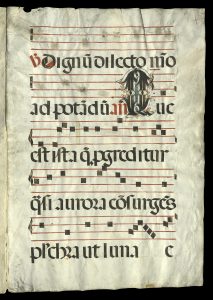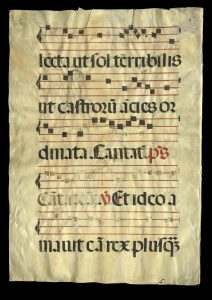Tags
antiphon, antiphonal, Apocalypse, Assumption of the Blessed Virgin Mary, benedictus, bifolia, Blessed Virgin Mary, Book of Esther, chant, Elizabeth Peterson, Esth .2:17, Esther, God, Holy Scripture, Israel, James T. Svensen, Jerusalem Bible, Latin, lauds, medieval, Old Testament, Portugal, Song of Songs, Spain, The University of Utah, Utah Museum of Fine Arts, Vashi, wine, Yahweh

(Guttur tuum sicut vinum optimum)
Dignu(m) dilecto meo ad pota(n)dum
Q(ua)e est ista q(uae) progreditur
q(ua)si aurora consurge(n)s
pulchra ut luna e-(lecta)
(and your mouth like an exquisite wine)
worthy for drinking (may it go) to my beloved…
Who is this who comes forth rising like
morning, beautiful like the moon,

lecta ut sol terribilis ut castroru(m) acies
ordinata Cantan Ps(almum)
Et ideo amavit eam(,m) rex plusq(ua)m (omnes mulieres)
resplendent
like the sun, terrible like an army arrayed for battle?
And therefore he loved her more than (all the other women)
This folio, like several others in the collection, is devoted to the celebration of the Assumption of the Blessed Virgin Mary on August 15th. It was the antiphon sung at the Benedictus for lauds early in the morning and urged the faithful to rejoice: “gaudete et exultate…qui hodie Maria Virgo cum Christo regnat per eternum. Alleluja” (“Rejoice and exult…because today the Virgin Mary reigns with Christ in heaven forever. Alleluia!”) The first selection on the recto is from the Song of Songs, a series of love poems in which lover and beloved, bridegroom and bride, are united, divided and united again. Often the series is interpreted allegorically: the relationship signifies a true human relationship sanctified by marriage or it signifies the relationship between Yahweh and Israel. In the text the bridegroom introduces the metaphor of wine, and the bride responds with similarly: “your speaking, superlative wine/wine flowing straight to my Beloved” (Jerusalem Bible). The text continues with the Bridegroom’s question: “Why is this arising like the dawn, fair as the moon, resplendent as the sun, terrible as an army with banners?” (Jerusalem Bible). Here more specifically the relationship seems to be the relationship between God and the Blessed Virgin Mary with God questioning who she is as she is assumed into heaven. Note that the simile “quasi aurora consugens” is highly appropriate, and some other later texts emend “progreditur” to “ascendit” to heighten the upward momentum for the “rising” Mary. Thus the bride of the allegory is not only Israel, the Church or individual soul but also the Blessed Virgin Mary as queen of heaven and arrayed for the battle against evil, perhaps even as the woman of the Apocalypse. This is the reason Holy Scripture refers to Our Lady as “terribilis ut castrorum acies ordinata,” as terrible as an army set in battle array.” The Church also says that it is she alone who smashes all heresies. To celebrate this fact, in statues of the Immaculate Conception, Our Lady is crushing the head of the evil serpent.
At the bottom of the verso the text alludes to the Blessed Virgin Mary in the context of the Old Testament and the Book of Esther: “And the king loved Esther more than all the women, and she found favor and kindness with him more than all the women, and she found favor and kindness with him more than all the virgins, so that he set the royal crown on her head and made her queen instead of Vashti” (Esth.2:17). In a figural reading the king’s love for Esther is a type prefiguring God’s love for Mary above all others. It also prefigures her immaculate conception as virgin and establishes her place as queen of heaven, a fitting allusion on the Feast of the Assumption.
~Transcription, translation, and commentary by James T. Svendsen, associate professor emeritus, World Languages and Cultures, The University of Utah
MS chant frag. 4 — Part of a parchment bifolia from an Antiphonal, 16th c. Spain/Portugal.
~Description by Elizabeth Peterson, associate professor, Dept. of Art & Art History, The University of Utah, from Paging Through Medieval Lives, a catalog for an exhibition held November 2, 1997 through January 4, 1998 at the Utah Museum of Fine Arts.

You must be logged in to post a comment.